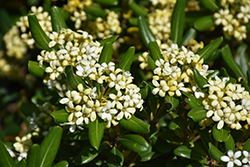Fri & Sat 8am - 8pm
Sun 8am - 7pm
Anytown, USA 12345
fax: 261.787.0463
e-mail: info@successgc.com


Plant Finder

Height: 4 feet
Spread: 4 feet
Sunlight:
![]()
![]()
Other Names: Japanese Pittosporum, Japanese Cheesewood
Description:
An excellent indoor accent plant; emerging foliage is yellow gold, maturing to dark glossy green; pretty clusters of white flowers in late spring; an attractive selection that is easy to care for
Features & Attributes
Japanese Mock Orange is bathed in stunning clusters of white cup-shaped flowers at the ends of the branches from late spring to early summer, which emerge from distinctive pink flower buds. Its attractive glossy oval leaves emerge chartreuse, turning dark green in color throughout the year.
This is a dense multi-stemmed evergreen houseplant with a more or less rounded form. This plant can be pruned at any time to keep it looking its best.
Planting & Growing
When grown indoors, Japanese Mock Orange can be expected to grow to be about 4 feet tall at maturity, with a spread of 4 feet. It grows at a fast rate, and under ideal conditions can be expected to live for approximately 40 years. This houseplant will do well in a location that gets either direct or indirect sunlight, although it will usually require a more brightly-lit environment than what artificial indoor lighting alone can provide. It does best in average to evenly moist soil, but will not tolerate standing water. The surface of the soil shouldn't be allowed to dry out completely, and so you should expect to water this plant once and possibly even twice each week. Be aware that your particular watering schedule may vary depending on its location in the room, the pot size, plant size and other conditions; if in doubt, ask one of our experts in the store for advice. It is not particular as to soil type or pH; an average potting soil should work just fine.
There are many factors that will affect the ultimate height, spread and overall performance of a plant when grown indoors; among them, the size of the pot it's growing in, the amount of light it receives, watering frequency, the pruning regimen and repotting schedule. Use the information described here as a guideline only; individual performance can and will vary. Please contact the store to speak with one of our experts if you are interested in further details concerning recommendations on pot size, watering, pruning, repotting, etc.
-- THIS IS A HOUSEPLANT AND IS NOT MEANT TO SURVIVE THE WINTER OUTDOORS IN OUR CLIMATE --
